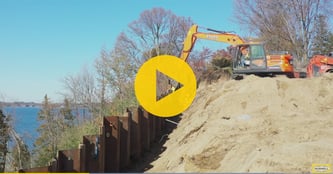
Major renovations to Rickards High School in Tallahassee, Florida included two new classroom buildings which were planned for construction at the base of a large hill. Prior to construction of the buildings, a concrete soldier pile wall was to be built to retain the hill.
The wall would need to be installed close to several existing buildings and while classes were still in session. To minimize the disruption to the classes, the wall would need to be constructed with small construction equipment in a short amount of time.

Sewer, gas, fire, and water mains all crisscrossed the area where the wall was being constructed. To prevent the need for large equipment and to keep the excavations for the soldier piles as small as possible, the design team wanted to use an anchor system to help resist the loads that would be applied to the soldier piles.
CHANCE helical anchors were chosen to tie back the soldier piles. This shortened the overall length of the piles and helped to reduce their diameter thus preventing the need for large equipment to install the piles.
 The helical pile installing contractor was Mason Grady Foundations, an experienced team of CHANCE Certified Installers. The helical anchors were installed at varying angles so they could be installed around the existing utilities and were also installed with small construction equipment. Eighty-nine CHANCE square shaft anchors (SS125, SS5, and SS150) at 8-32-kip allowable capacities were installed to secure the concrete piles for the retaining wall.
The helical pile installing contractor was Mason Grady Foundations, an experienced team of CHANCE Certified Installers. The helical anchors were installed at varying angles so they could be installed around the existing utilities and were also installed with small construction equipment. Eighty-nine CHANCE square shaft anchors (SS125, SS5, and SS150) at 8-32-kip allowable capacities were installed to secure the concrete piles for the retaining wall.
The anchors were pre-tensioned immediately after installation so that as soon as a section of the anchors was installed and tensioned the wall was immediately being formed and poured.
Additional Reading: 3 Advantages of Helical Tiebacks vs Conventional Grouted Tendon Methods
How it works
A helical tieback anchor is installed by rotating or screwing it into the ground. Each helical bearing plate is formed into a screw thread with a uniform defined pitch. The tieback anchors are installed into the ground until the helical plates are located in load bearing soil. The tieback anchor is then attached to the wall face.

Watch a Tieback Installation
Benefits of CHANCE Helical Tieback Anchors
- Immediate loading - no grout cure time
- Typical production rate of 30-40 per day for installing / testing
- Cuts labor and equipment costs
- Cost-effective while obtaining high anchor load capacities
- Predictable results
- Proven engineered system
- Labor-saving - smaller crews
- No pre-drilling
- Site specific to conditions and loads
- Terminations available for various thread bars
- Load transfer by end-bearing, not skin friction
- Extendable with bolted joint connections
- Removable and reusable

About the installing team
Mason Grady Foundations, with locations in Georgia and Florida, is a family owned and operated deep foundation construction company and CHANCE Certified Installer. With construction services for commercial, institutional, and residential clients, MGF provides a foundation to build on through strong working relationships, trust, ethics, pride and a safety-focused culture.

